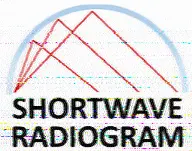Sun 01 October 2017
 This weekend's reception of Shortwave
Radiogram was cut off at the beginning due
to an operator error. I had left my computer up and listening to
WRMI but had also left the automatic frequency
control (AFC) feature turned on. This meant that fldigi ended up
surfing around the bandpass instead of locking onto the signal and
decoding it. Luckily I came up to the shack in the nick of time and was
able to correct the problem.
This weekend's reception of Shortwave
Radiogram was cut off at the beginning due
to an operator error. I had left my computer up and listening to
WRMI but had also left the automatic frequency
control (AFC) feature turned on. This meant that fldigi ended up
surfing around the bandpass instead of locking onto the signal and
decoding it. Luckily I came up to the shack in the nick of time and was
able to correct the problem.
Here is my download of this weekend's Shortwave Radiogram:
deployments. The hams and their equipment will be sent to Red
Cross shelters extending from San Juan to the western end of the
island.
"This generous outpouring of response represents the finest
qualities of the Amateur Radio community," ARRL CEO Tom
Gallagher, NY2RF, said. "These individuals are dropping whatever
they are doing now, heading off to an extended hardship-duty
assignment, and offering their special talents to Americans who
have been cut off from their families, living amid widespread
destruction and without electrical power since Hurricane Maria
struck the Caribbean region last week."
ARRL's Emergency Preparedness Manager Mike Corey, KI1U, said this
was the first time in the nearly 75-year relationship between
ARRL and the American Red Cross that such as request for
assistance had been made. "Hurricane Maria has devastated the
island's communications infrastructure," Corey said. "Without
electricity and telephone, and with most of the cell sites out of
service, millions of Americans are cut off from communicating.
Shelters are unable to reach local emergency services. And,
people cannot check on the welfare of their loved ones. The
situation is dire."
Image: NOAA satellite images of Puerto Rico before and after
Sending Pic:437x101;

This is Shortwave Radiogram.
Please send reception reports to radiogram@verizon.net
From the BBC Media Centre:
BBC News launches Korean language service
25 September 2017
The new Korean language service announced in November 2016 by the
BBC World Service began broadcasting today. Audiences in the
Korean peninsula and Korean speakers around the world can now
hear radio broadcasts and access the latest news online at
BBC.com/korean .
BBC News Korean is one of 12 new language service launches now
underway as part of the biggest expansion of the BBC World
Service since the 1940s, funded through a £291 million grant in
aid from the Foreign and Commonwealth Office.
Director of the BBC World Service Francesca Unsworth says: "BBC
News Korean will build on the long-standing reputation for
fairness and impartiality the BBC World Service has earned all
over the world."
BBC News Korean features a daily 30-minute radio news programme
broadcast at 15.30 GMT on Shortwave (SW) and 16.30 GMT Medium
wave (MW). The service will also feature a digital offer with
written stories, videos and radio programmes which can be
downloaded and shared. The new service features a wide range of
news, sport, business, culture, in-depth reports and English
language learning.
BBC News Korean journalists will be based in Seoul, London and
Washington and will draw on the full extent of the BBC's global
network of correspondents.
Notes:
Service launched Monday 25 September at 15.30 GMT (Tuesday 26
Shortwave service to broadcast for three hours, 15.30 - 18.30
Medium wave service transmission for 1 hour 16.30 - 17.30 GMT
All transmissions to be 7 days a week
Medium wave (MW) Frequency: 1431KHz
Shortwave (SW) Frequencies: 5810 kHz & 9940 kHz (from launch
to 28 October 2017) then; 5810 kHz & 5830 kHz (from 29 October
2017 to 24 March 2018)
The BBC News Korean website will be available at BBC.com/korean
The BBC World Service is currently launching in 12 new languages
- Afaan Oromo, Amharic, Gujarati, Igbo, Korean, Marathi, Pidgin,
Punjabi, Serbian, Telugu, Tigrinya, and Yoruba.
http://www.bbc.co.uk/mediacentre/latestnews/2017/bbc-news-launches-korean-language-service
Image: From BBC video comparing North and South Korean usages of
Sending Pic:230x103C;
This is Shortwave Radiogram.
Please send reception reports to radiogram@verizon.net
From New Atlas:
Highest-capacity transatlantic data cable completed
The highest-capacity data cable stretching across the Atlantic
has now been completed. A consortium including Microsoft,
Facebook and Telxius recently finished threading the complex
4,000-mi (6,400-km) cable across the ocean floor from Virginia
Beach, Virginia to Bilbao, Spain to produce a high-speed data
connection that will be more secure from disruption by natural
disasters.
Though modern telecommunications may conjure up images of lasers
skittering between communication satellites high above the Earth,
the backbone of today's internet is heavily dependent on a giant
spider web of cables spanning between continents and along coast
lines carrying everything from tweets to high-definition live
streaming videos.
Unfortunately, these cables are vulnerable to natural and manmade
disasters. In the aftermath of the October 2012 Hurricane Sandy
that wreaked havoc on the east coast of the United States,
wireless, internet, and home telephone services were knocked out
for days. Therefore, it was decided by Microsoft and Facebook,
along with Telxius, to develop, design, build, and lay a new
cable farther south than existing transatlantic connections.
Work on the new cable, called Marea or "Tide" in Spanish, began
less than two years ago and Microsoft says the project was
completed three times faster than a typical undersea cable
project. The route for the cable required the surveying of the
seabed to depths of up to 11,000 ft (3,300 m) to avoid hazards
that include active volcanoes, earthquake zones, and coral reefs.
Marea consists of eight pairs of fiber optic cables encased in
copper, a hard-plastic protective layer, and a waterproof
coating. The whole thing measures 1.5 times the diameter of a
garden hose and is buried in a set of trenches close to shore to
protect it from fishing nets and anchors, but lies open on the
seabed in the mid-ocean.
Marea is expected to go operational early next year when it will
carry up to 160 terabits of data per second, which is 16 million
times faster than the average home internet connection. This is
the equivalent to 71 million high-definition videos streaming
simultaneously and will allow the cable to serve hubs in Africa,
the Middle East, and Asia. In addition, its open design will
allow it to be upgraded as demand grows.
"Marea comes at a critical time," says Brad Smith, president of
Microsoft. "Submarine cables in the Atlantic already carry 55
percent more data than trans-Pacific routes and 40 percent more
data than between the US and Latin America. There is no question
that the demand for data flows across the Atlantic will continue
to increase and Marea will provide a critical connection for the
United States, Spain, and beyond."
http://newatlas.com/highest-capacity-transatlantic-cable/51488/
Image: Route of the Marea cable between Spain and Virginia ...
Sending Pic:228x71C;
Finally, this photo of a young Anatoly Karpov, Soviet chess
grandmaster, includes his multiband portable radio -- probably
capable of receiving shortwave ...
Sending Pic:346x254;
Transmission of Shortwave Radiogram is provided by:
WRMI, Radio Miami International, http://wrmi.net
and
Space Line, Bulgaria, http://spaceline.bg
Please send reception reports to radiogram@verizon.net
And visit http://swradiogram.net
Twitter: @SWRadiogram
I'm Kim Elliott. Please join us for the next Shortwave
Sending Pic:192x151C;

 This weekend's reception of Shortwave
Radiogram was cut off at the beginning due
to an operator error. I had left my computer up and listening to
WRMI but had also left the automatic frequency
control (AFC) feature turned on. This meant that fldigi ended up
surfing around the bandpass instead of locking onto the signal and
decoding it. Luckily I came up to the shack in the nick of time and was
able to correct the problem.
This weekend's reception of Shortwave
Radiogram was cut off at the beginning due
to an operator error. I had left my computer up and listening to
WRMI but had also left the automatic frequency
control (AFC) feature turned on. This meant that fldigi ended up
surfing around the bandpass instead of locking onto the signal and
decoding it. Luckily I came up to the shack in the nick of time and was
able to correct the problem.


